Mawem Brothers Dominate Climbing’s Olympic Debut
Olympic Sport Climbing began this morning. After the Mawem brothers dominating performance, there is unclear who will walk away with gold
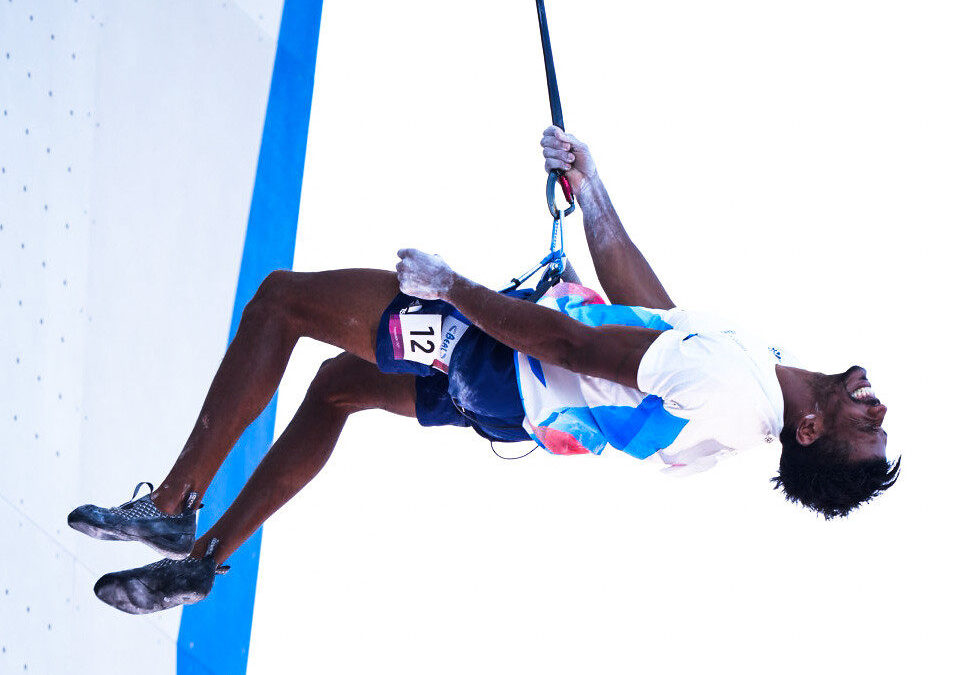
It promised to be unprecedented. The combined format alongside the Olympic stage offered something unique from conventional international competition.
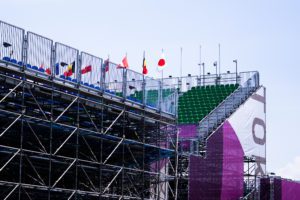
Despite this fact, many would try to predict outcomes. Sport Climbing’s Olympic inauguration would prove many of these hypotheses false.
Speed
For North Americans, the Men’s Qualification event began early this morning. As spectators rubbed their eyes in front of their computer screens, Olympic hopefuls took to the 15-metre Speed wall on the right side of the venue. The two-heat event had athletes pushing personal best, alongside several upsetting attempts by some of the discipline’s strongest athletes.
Although Italy’s Ludovico Fossali did hold the title of Speed World Champion from 2019, the Italian climber could not put down a quick run over the course of the round. To that effect, the Czech Republic’s Adam Ondra claimed 18 position, pushing his ranking to the back of the pack. This result was expected.
Perhaps the first exciting run of the day came from France’s Bassa Mawem. The French Speed Champion, and fastest vertical man in Tokyo, threw down what would become the Olympic record. He ran a 5.45 in his first heat ultimately claiming first position for that round of competition.
Teammate and brother Mickael Mawem would join Bassa in a sub six-second speed lap, taking 5.95 and third position for the round. Although Mickael does feature a great deal of strength, such a result surprised most everyone. It quickly became clear that Mickael had come to Tokyo prepared.
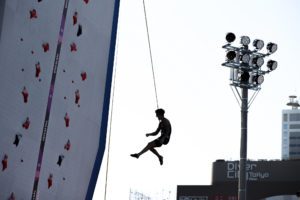
Team Japan’s Tomoa Narasaki would split the difference between the two brothers. He ran a 5.94 heat. Taking confidence in his time and position, Narasaki declined his second heat in an effort to save energy. Due to the fact that Narasaki had no chance of defeating Bassa, this tactical decision appeared wise. It would show a competitive prowess.
Among those that climbed well in Speed, a few names stuck out from the rest. Korea’s Jongwon Chon climbed into fifth with a 6.21 while America’s Colin Duffy climbed a personal best of 6.23. Furthermore, Spain’s Alberto Ginés López climbed a fantastic 6.32.
Duffy has stood out this year for climbing with progressively greater competitive proficiency. His strength became obvious on the Speed route where he appeared to move in perfect flow. Jongwon Chon stood out due to the fact that he, on his best day, boulders as hard, or near as hard as Narasaki. A strong result in Speed and also Boulder seemed like they could push the Korean into Finals.
Finally, López performed well in Speed. This came as a surprise as he climbed poorly in Speed in Villars. Of course, López did decide to use the World Cup circuit as training for the Olympics and so his results in those competitions might not reflect his potential.
These three became athletes to watch as the rounds flipped from Speed to Boulder.
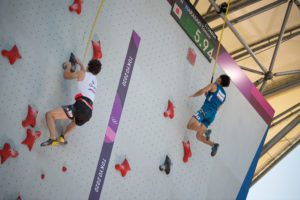
Boulder
The Boulder round took place on the centre wall of Tokyo’s Aomi Urban Sports Park. Although the wall itself appeared exciting, the boulders were somewhat simple. Naturally, simple does not really reflect Olympic-level climbing, but after a season the featured a variety of depth, both in movement and relative dimensionality, B1 appeared almost underwhelming.
The bloc required athletes to establish on two almost-symmetrically placed triangular boxes that challenged though balance and friction. Where some athletes would move easily through the bottom, others would never make it to the Zone. Achieving the Zone required climbers to dig into an intermediate gib on the corner of a higher-placed volume before moving to a friction Flathold Revival volume. Athletes would then rock a foot onto the intermediate gib, and rock-to-press into the final hold.
Naturally, this ended up having numerous betas. It became clear that Duffy had showed up to the Games when he broke the beta. Duffy crimped the 6-8 millimetre flange of the volume, matched that flange and then moved to the finish. No one else would climb it this way.
Duffy would manage to climb well enough to make it through the round in fifth position. Stiil, neither he, nor most any other athlete would be able to touch B2. The overtly uncomfortable boulder problem forced climbers into a balanced crimping sequence that potentially offered numerous beta solutions.
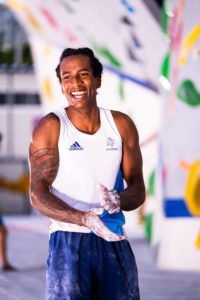
To climb it, however, the athlete would have to press their fingers onto a thin sloping edge and shoulder-out to a volume on the left side. Once secure, the athlete would then move to a left facing gaston that forced an aggressive iron cross to the finish. After consecutive failures, Alex Megos would finally crack the move and achieve the Zone on that Gaston. He would then fall.
Athletes such as Adam Ondra and Jongwon Chon would give it their best efforts as well, but neither would achieve Zone. It would take Mickael Mawem to not only determine how to do the boulder, but also flash it. Although Narasaki would complete the boulder as well, it would take him four attempts.
Mawem’s flash would pair well with his flash of B3 and cement his place in the lead. B3 appeared rather simple, but deceivingly so. The problem required climbers swing, stand, paddle and catch a one-handed hueco. At first, this move appeared to be the crux. Instead, the final move, a difficult rock-to-stand-to-press-to-match sequence had many athletes falter. Mawem, however, appeared lighter than air and simply crushed the problem.
By contrast, neither Ondra nor Narasaki would complete the boulder. With that said, Duffy did.
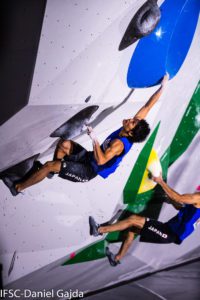
Each of these boulder problems ultimately culminated in the final bloc. B4 required athletes to complete a friction dependent, front-lever-like inversion to simply begin the problem. This alone provided great difficulty. Once through this section, athletes would establish a bat-hang that they would then match their hands to before moving out left to 2021’s favourite feature: a crack.
Unlike many cracks, this one appeared forced. Very few athletes would complete this boulder, but it would secure Ondra his third-place position. Neither Narasaki nor Mawem would be able to repeat this problem, but this did not appear consequential. Mawem climbed every other boulder and Narasaki appeared to know he had already earned second and, as such, saved energy by leaving B4 with over 45 seconds left on the clock.
While the round saw little in the way of López, he climbed with enough proficiency to retain contention. After a tough result in Speed, Austria’s Jakob Schubert completed the Boulder event in seventh. Schubert would most show his skill on Lead.
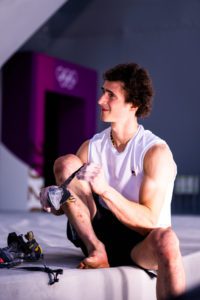
Lead
The event kicked off with a broken-hearted Christopher Cosser who, despite looking strong and well rested, would dry-fire relatively low down. Duffy would climb soon after and almost take the route to the Top. Once more, it became easy to doubt this dark horse. For some, it might have seemed as though the route did not offer enough difficulty considering how low in the rankings Duffy originated.
As the event progressed, it became clear that this did not reflect the truth. Instead, athlete after athlete would give their attempt, falling lower than Duffy. Although López would come close, he still fell a hold and a movement away from Duffy. The pair held their lead through the next competitors.
A few climbers after López, Bassa Mawem joined the field for what would become a debilitating attempt. The French climber would reach over his body to a hold, extending his left arm before reaching the grip. Upon weighting the extended bicep, he would fall in pretty obvious pain.
Once om the ground, he began to pull his bicep downward. He appeared to have damaged his bicep tendon. In slow motion, it became obvious that what occurred to Mawem resembled an injury. Despite that fact, he would move on to Finals after competing so well in Speed.
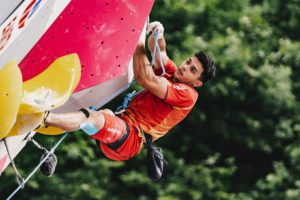
This injury definitely shook the spectators watching at home. It became clear that this format did provide a brutal form of competition. Although many climbing fans did recoil, Czech superstar Adam Ondra followed Mawem and the competition continued almost without pause.
The Czech climber moved well, but appeared tired and would fall lower than López and Duffy. As Ondra was only the tenth climber out, it appeared possible that Ondra might not make Finals depending on the remainder of the field.
Ultimately, he would have no reason to fear. Only Jakob Schubert would climb beyond the leaders, both cementing his position in Finals and showing how uncertain this format of competition can become.
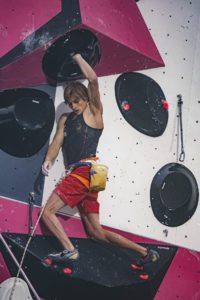
Conclusions
In the end, the day would go to Mickael Mawem. His impressive performance showed another level of competition that outstripped his competitors. It will become interesting to see how he recovers today, and whether he can replicate his outstanding performance in Finals. If he can, he has the capacity to be Tomoa in Speed. If that occurs, Mawem could become the Olympic Champion.
Despite this, Narasaki remains the favourite. His consistency and competitive skill make him difficult to defeat. To that effect, Ondra will have to wake up ready to rock should he want to win Olympic Gold. Furthermore, Narasaki will also have to falter. It appeared as though Narasaki decided to not overcommit in Lead today. As such, it might not be wise to project his Lead performance based on today’s result.
Furthermore, Duffy has also risen to contention. If Ondra continues climbing as he did today, Duffy could medal. Still, among the men in Finals it does appear like a situation where whomever is best on the day will win. The field, at this time, remains difficult to separate through projections.
To that point, congratulations to the route setters. They have set a perfectly separated competition so far.
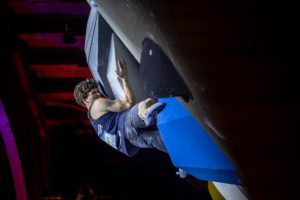
While the Men will have to wait for an August 5 Finals, Women’s Qualification begins tomorrow at 4:00 am EST. If today provided any indication, it shows that the Olympics differ from conventional Word Cup competition. It will become interesting to see how the field stacks up against Slovenia’s Champion, Janja Garnbret.
Result
Athletes Advancing to Finals:
1 – Mickael Mawem (FRA) 33.00
2 – Tomoa Narasaki (JPN) 56.00
3 – Colin Duffy (USA) 60.00
4 – Jakob Schubert (AUT) 84.00
5 – Adam Ondra (CZE) 216.00
6 – Alberto Gines Lopez (ESP) 294.00
7 – Bassa Mawem (FRA) 360.00
8 – Nathaniel Coleman (USA) 550.00
Featured image of Bassa Mawem by Daniel Gajda.


